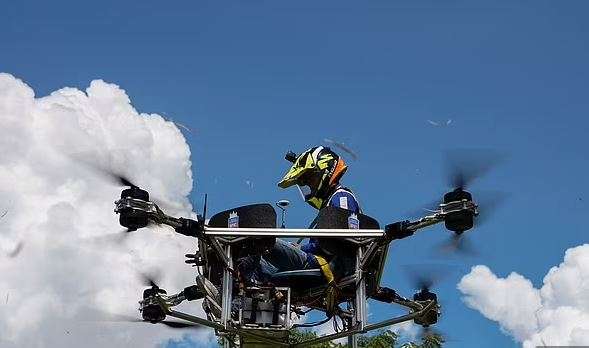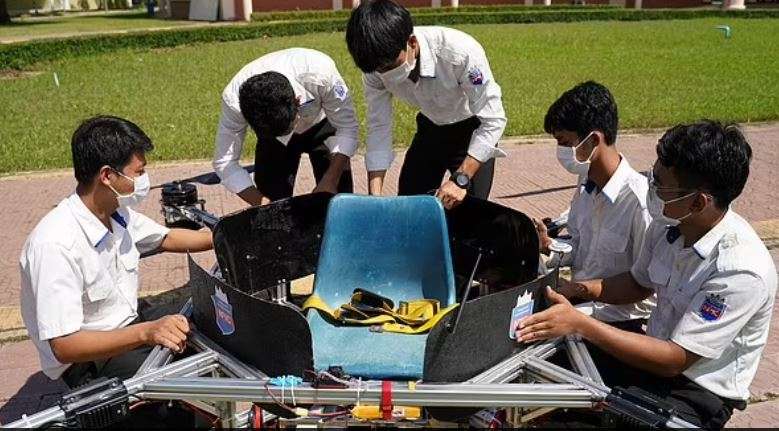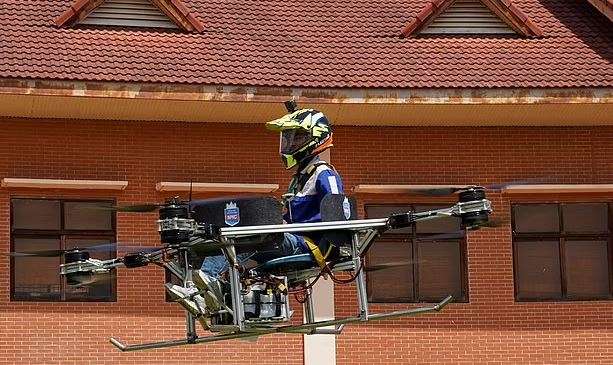Students in Cambodia have designed a prototype manned drone from a rather unexpected piece of furniture – a school chair, to aid their community.
The group of Cambodian students were inspired at first by a desire to beat;the city’s notorious traffic to design a prototype;drone that it hopes can eventually be used to ferry people around Phnom Penh.
The youngsters at the National Polytechnic Institute of Cambodia (NPIC) spent $20,000 (£14,000) transforming the school chair into a drone, equipping it with eight propellers that allow it to fly to heights of around 13.1 feet (four metres).
In the future, the team hopes to improve the design to carry more weight and fly even higher. The team believes the drone could also help firefighters to access fires on upper floors of buildings someday.
“The drone, when we see it flying without a pilot, there is a lot of shaking but when I sit on it and fly… it becomes more stable and I feel so excited”, said Lonh Vannsith, 21, the pilot of the drone.

“We wanted to solve some problems for our society by making a taxi drone and… inventing drones for firefighters,” he said, noting how, for example, they hoped it could reach the upper floors of a building to bring a hose where a fire truck could not reach.
Years of research to build the prototype
The prototype can carry a pilot weighing up to 60 kg (132 pounds) and fly for;about 10 minutes for a distance of 1 km (0.6 miles). In addition to the cost of $20,000, it took three years of research and development to build the prototype.
The project delayed because of lockdowns during the COVID-19 pandemic;and also as components like the propellers and the frame had to be ordered abroad, said Sarin;Sereyvatha, who is NPIC’s head of research and development technology.

The team plans to improve the design to allow it to take more;weight, as well as fly further and more stably at a higher level.
“In principle, if we make one drone, the cost is expensive but if we make them to sell on the market, the cost will go down,” said Sarin Sereyvatha.
Other developers of small manned drones
The students aren’t the only ones working on a small manned drone. Last year, a Japanese startup called SkyDrive began conducting test flights of a similar device.
Former engineers from Toyota founded SkyDrive with the intention of making its vehicles ‘the world’s smallest flying car.’
In 2017, Toyota gave the company an infusion of around $350,000 (or 40million yen) to help develop flying vehicles.
The company said it won’t say more about how the test flights have been proceeding so far, but says things are going well enough to continue making them.
Future of flying taxi
Advances in electric motors, battery technology and autonomous software has triggered an explosion in the field of electric air taxis.
Larry Page, CEO of Google parent company Alphabet, has poured millions into aviation start-ups Zee Aero and Kitty Hawk, which are both striving to create all-electric flying cabs.
Kitty Hawk is also developing a flying car and has already filed more than a dozen different aircraft registrations with the Federal Aviation Administration.
Page, who co-founded Google with Sergey Brin back in 1998, has personally invested $100 million (£70 million) into the two companies, which have yet to publicly acknowledge or demonstrate their technology.
Airbus is also hard at work on an all-electric, vertical-take-off-and-landing craft, with its latest Project Vahana prototype, branded Alpha One, successfully completing its maiden test flight in February 2018.
READ ALSO: AJ bows to Ukrainian underdog, suffers second shocking defeat






















